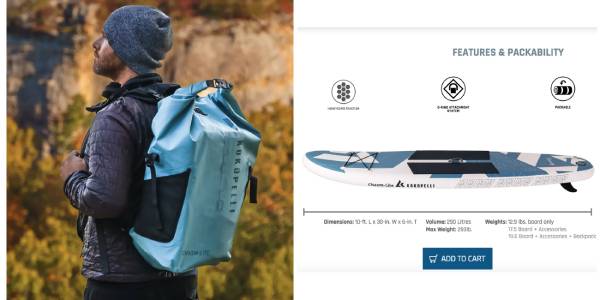If you want to learn a new surfing trick, go for it, but don’t expect to get it perfect the first time. It’s normal to fall a few times before you’re able to land the trick. In fact, you should expect to fail or fall about 300 times before you get it right.
This can be used as a great learning tool for just giving maneuvers a go and eventually you will have it down.
When you’re trying to improve your surfing, it can be helpful to break down the movement into smaller, more manageable parts. For example, focus on what your hands and legs should be doing in preparation and execution.
By doing this, you’ll have a better understanding of how to perform a tight arch or a passionate pop.
Ways To Improve Your Surfing
The most obvious way to improve your surfing skills is to surf more frequently. Even if the waves are small, getting in the water on a regular basis will help build your skills and knowledge about waves.
If you live further from the surf, try to get in the water as much as possible to stay accustomed to the movements and to keep progressing.
Equipment
Make sure you are honest with yourself when selecting a surfboard. If you’re relatively new to surfing, it’s best to find a board that doesn’t require too much effort to catch waves and doesn’t sink when the wave’s momentum dissipates.
Even professional surfers have difficulty finding the perfect board, so don’t get too attached to one that’s just okay. Be willing to try new boards with different dimensions until you find the perfect one for you.
The right board is essential for surfing, and you’ll quickly feel the difference in how some boards can turn or plane faster, and some paddle more easily. There is no perfect all-round board that works great in 1-20 foot waves, but you can have a range of boards to cover all possible conditions.
A quiver of specifically designed boards for 1-4 foot or 4-8 foot surf will all require different styles and shapes to get the best performance. Surfing different shapes and size boards will help you increase your surfing ability and improve your skills.
Stretch
If you’re looking to improve your surfing, now is a good time to start stretching. Staying flexible is important for flowing movements and reducing the risk of cramps while surfing.
Just 5 minutes a day can make a big difference in your surfing style.
Flexibility
Most people stand too tall while surfing. This is mostly due to stiffness in the legs, hips, and back and results in a lack of power and control. To fix this, focus on stretches that allow you to get into a low position with a straight back and weight centered on your feet.
Just doing a normal squat, and working toward correcting your form, will stretch and strengthen you in that position.
Fitness
One should be cautious against working out with the intention of building muscles that will only look good in the mirror as this can have a negative impact on surfing performance. Surfing requires quick bursts of speed and power, which can be achieved through gradually increasing the intensity of bodyweight exercises.
In order to get in shape for surfing, it is important to mimic the movements you will be doing in the water as closely as possible. This will help to improve your strength, power, and endurance.
Some key areas to focus on are paddle exercises and cardiovascular fitness, which will help with paddling out and breathing, and exercises that target the legs and core stability, which will help with power, speed, and balance in your turns.
Warm Up Before Session
A proper warm-up is a prob
It can be difficult to motivate yourself to do awarm-upbefore going surfing, especially when the waves look so enticing. However, taking a few minutes to stretch and jump around will help you catch more waves later on and reduce your risk of injury.
A good warm-up should last between 5 – 10 minutes. Consider what surfing physically demands when planning your warm-up – squatting, twisting, jumping, landing, pushing up, popping up, and paddling.
Find a routine that will make you slightly sweaty when you’re finished and makes you feel overall more prepared. You will feel a difference and, hopefully, that difference will become addicting.
Lining up Your Peak
When you are surfing, it is better to paddle to a specific spot and stay there, rather than chasing the waves. Before you paddle out, find a spot where you want to surf and walk to that spot.
Find a landmark that you can easily see when you are surfing so that you know where to paddle back to. You will catch more waves if you stay in one spot.
Rhythm
We sometimes get so excited to shred that we fail to stay relaxed and build slowly into a surf. Creating a proper rhythm is important to any good session. Try to breathe slowly as you paddle out, releasing any tension you might have from the day.
Find your happy place. From there, the session should start slow, just going down the line and keeping a nice flow. As the surf progresses, increase your attack level.
Stance
The most common mistake in wave riding is incorrect stance. Most boards have a sweet spot near the back tail which is usually the fastest and loosest part of the board. It is normally located on top or just in front of the back fin on a three-fin board.
Place your front foot accordingly in order to find this spot. Another common mistake is having too much weight on your front foot. The ideal weight distribution is 55 percent on the front foot and 45 percent on the back foot in order to utilize the magic spot on the back of the board.
Remember that you may need to adjust your feet or weight distribution occasionally, but the foundation should be as described above.
Approach
You will have more success surfing if you take off at an angle parallel to the beach and try to stay near the top of the wave.
If you drop down to the bottom of the wave, you will likely go more slowly and have difficulty timing your turns.
Low Stance / Low Arms/ Ready Position
Try to keep your body close to the ground when you’re surfing. It requires a lot of discipline and strength to stay in that position, which is why the pros make it look so easy. Staying low gives you more stability and power, and it also helps your body move more efficiently as one unit.
Keeping your arms close to your sides also helps with this. (For the backside, have your front arm close and your back arm straight behind you.)
Heel to Toe
Place your foot on the back of the board with most of your weight on your back foot. You should be at the top of the wave, waiting for your opportunity. Keep your arms at your sides and begin doing little turns from your heel to your toe to create a rhythm.
Let your hips and shoulders lead your board, as if you were pumping on a skateboard. Use the same principle when surfing and you will have more speed, be centered over your feet, and be on your way to smoother and better surfing. In other words, more fun!
Yoga
Yoga and surfing go hand-in-hand because they both require a lot of balance and flexibility.
Yoga helps to increase a surfer’s maneuverability and flexibility, while also strengthening their core muscles – all of which are key to a surfer’s performance.
Surf Different Beaches and Waves
You should surf different types of waves and different sizes of waves so that you can become a better all-around surfer.
Surf With Other Good Surfers
When you surf with someone who is better than you, it will help you improve your own surfing. This is because they will go out and surf in more challenging conditions and perform more difficult maneuvers.
Watching and learning from them will inspire you to try harder and reach new levels of surfing glory.
Improve Your Wave Knowledge
The most difficult thing about surfing is Wave Knowledge. Most surfers get better at it by spending more time in the water. If you have good ocean knowledge, it will be easier to find rips and line-up indicators. You will also be able to tell when to paddle out, and where to take off.
If you want to improve your wave knowledge, watch your local surf breaks for a long time. You can also learn from surf movies.
Have a Good Wetsuit
If you live in northern Europe ornorth America, a good wet suit will make a huge difference. If it fits well and is flexible andwarm, you’ll be able to keep surfing through most winters without your toes feeling like they’re going to drop off.
Enjoy Yourself
The best surfers are the ones who are having the most fun.
When surfers are smiling and enjoying the waves, they are relaxed and creative in the water, which allows their minds to become one with what the wave is doing.
Do Other Board Sports
Since many board sports come from surfing, it makes sense to use your skills across multiple platforms. Snowboarding, skateboarding, and other activities can help improve your balance and muscles, while also preparing your mindset for surfing.
Practicing certain moves on different surfaces can help you perfect them.
Surf With Friends
Surfing with a friend is a great way to push your surfing skills. They will keep you motivated as well as encourage you to try new things and surpass your limits.
Having a friend who is better than you will help you to experience new and more challenging conditions. Someone to look at in terms of technique and style.
Challenge Yourself
This advice can be useful for any sport – don’t get too comfortable once you’ve mastered the basics. Once you’ve mastered the 2-3 foot waves, try paddling out on days when the waves are 5-6 feet high.
You’ll be surprised how your instincts and muscle memory will take over, allowing you to make key maneuvers in critical sections of the wave. A little more size will also provide more speed.
This will help you improve your surfing.




